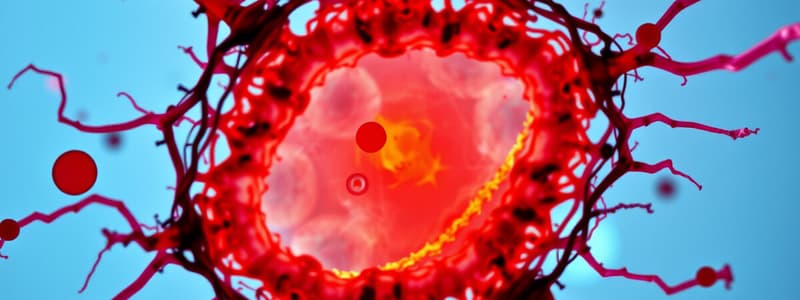Podcast
Questions and Answers
What is the primary function of mitochondria within a cell?
What is the primary function of mitochondria within a cell?
- Protein synthesis
- DNA replication
- Energy production (correct)
- Cell division
Which of the following is a characteristic feature of prokaryotic cells?
Which of the following is a characteristic feature of prokaryotic cells?
- Introns in genes
- Membrane-bound organelles
- Peptidoglycan cell wall (correct)
- Multicellular structure
What role does the ribosome play in the cell?
What role does the ribosome play in the cell?
- Synthesis of proteins (correct)
- Transport of genetic material
- Digestion of nutrients
- Regulation of cell division
Which cell structure is responsible for maintaining homeostasis?
Which cell structure is responsible for maintaining homeostasis?
What structure is the site of photosynthesis in plant cells?
What structure is the site of photosynthesis in plant cells?
What is the purpose of the #include directive in a C program?
What is the purpose of the #include directive in a C program?
What does the statement return 0; signify in a C program?
What does the statement return 0; signify in a C program?
Which of the following correctly represents a variable declaration in C?
Which of the following correctly represents a variable declaration in C?
What is the first step in the C compilation process?
What is the first step in the C compilation process?
Why is it important to end statements with a semicolon in C?
Why is it important to end statements with a semicolon in C?
Flashcards
Function of Mitochondria
Function of Mitochondria
Mitochondria produce energy for the cell.
Prokaryotic Cell Feature
Prokaryotic Cell Feature
A key characteristic is the peptidoglycan cell wall.
Role of Ribosome
Role of Ribosome
Ribosomes synthesize proteins in the cell.
Cell Membrane Function
Cell Membrane Function
Signup and view all the flashcards
Photosynthesis Site
Photosynthesis Site
Signup and view all the flashcards
Purpose of #include in C
Purpose of #include in C
Signup and view all the flashcards
Significance of return 0;
Significance of return 0;
Signup and view all the flashcards
Variable Declaration Example in C
Variable Declaration Example in C
Signup and view all the flashcards
First Step in C Compilation
First Step in C Compilation
Signup and view all the flashcards
Importance of Semicolon in C
Importance of Semicolon in C
Signup and view all the flashcards
Study Notes
C Language Overview
- A high-level programming language designed for system programming and embedded systems.
Basic Components of a C Program
- Preprocessor Directives
- Use
#includeto include standard libraries necessary for input/output operations.
- Use
- Main Function
- Defined as
int main(), it serves as the program's starting point.
- Defined as
- Variable Declarations
- Declaring variables defines their type, e.g.,
int a;signifies an integer variable.
- Declaring variables defines their type, e.g.,
- Statements
- Executable statements perform actions, such as
a = 5;which assigns a value.
- Executable statements perform actions, such as
- Return Statement
- Concludes the function with
return 0;, indicating the program terminated successfully.
- Concludes the function with
Sample Basic C Program
- Demonstrates the structure of a C program starting from preprocessor directives to output display.
- The program initializes an integer variable, assigns a value, prints that value, and returns a status code.
Key Concepts
- Data Types
- Fundamental data types include
int(integer),float(floating-point),char(character), anddouble(double-precision floating-point).
- Fundamental data types include
- Input/Output Functions
printf(): Used to print data to the console.scanf(): Used for reading user input.
- Comments
- Single-line comments initiated with
//. - Multi-line comments enclosed between
/*and*/.
- Single-line comments initiated with
Compilation Process
- Preprocessing
- Processes preprocessor directives like
#include.
- Processes preprocessor directives like
- Compilation
- Translates C code into machine language.
- Linking
- Merges object files and libraries to produce an executable program.
Important Tips
- End every statement with a semicolon (
;) to prevent syntax errors. - Maintain proper indentation and formatting for code readability.
- Troubleshoot by checking for syntax errors during the compilation phase.
Studying That Suits You
Use AI to generate personalized quizzes and flashcards to suit your learning preferences.



